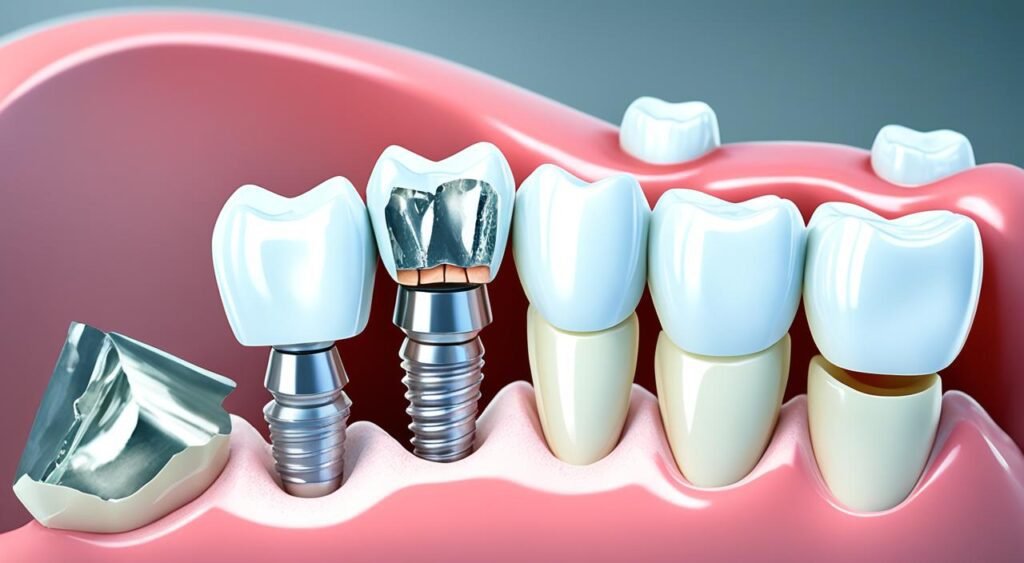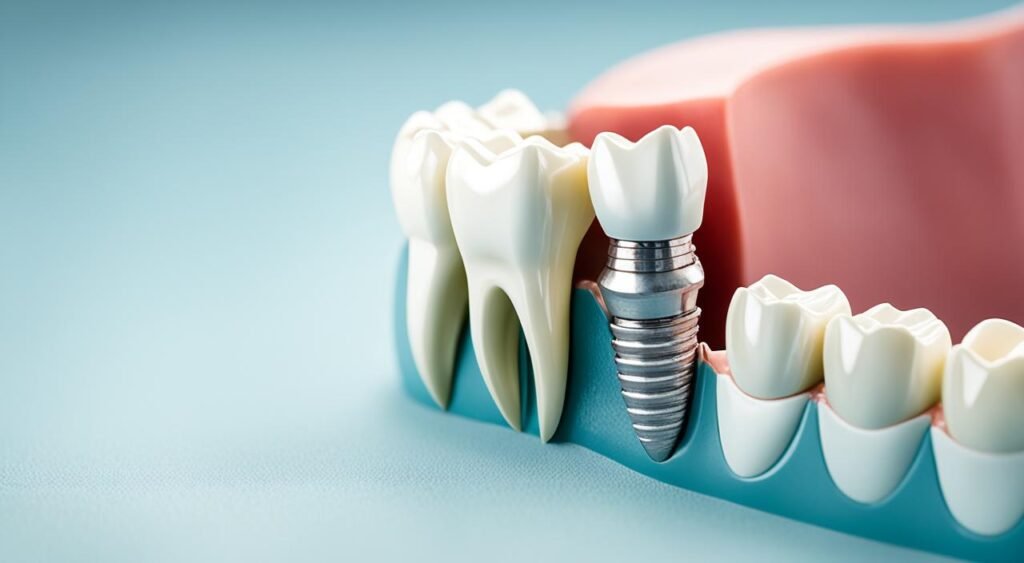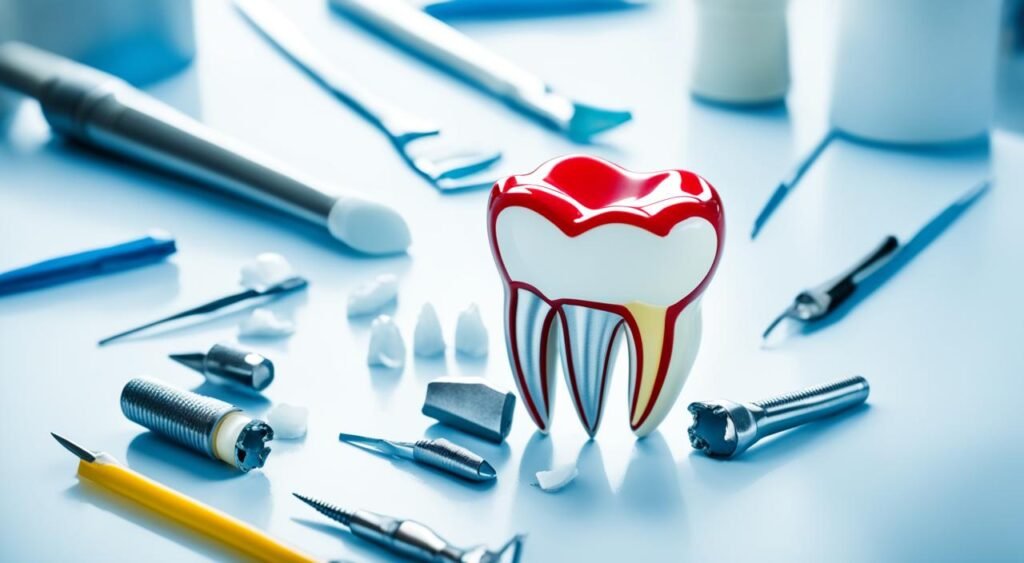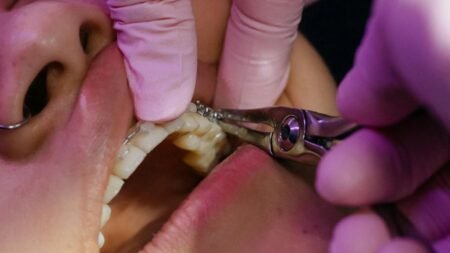Accidents can lead to broken teeth. In the U.S., over five million teeth are knocked out each year. It’s vital to know your options for fixing a broken tooth and the broken tooth repair cost. Affordable choices are available. Dental bonding can cost between $300 and $600 for each tooth.
On the other side, there are dental implants which can go up to $5,000 per tooth. Acting quickly helps avoid extra pain, infections, and possibly losing the tooth. But finding the best care for a broken tooth near you is crucial. Let’s explore how to fix your smile without spending too much.
Key Takeaways
- Dental bonding presents an inexpensive and versatile option for many chipped teeth, with prices ranging between $300 and $600 per tooth.
- For a more durable and aesthetic fix, porcelain veneers and dental crowns offer a robust solution, yet with higher costs compared to bonding.
- Addressing your broken tooth within 12 hours is crucial for the best chance of saving it, preventing further complications.
- Annual limits on dental insurance can affect your out-of-pocket costs, making dental savings plans a significant consideration.
- Understanding the various repair methods and their costs can help you make an informed decision when seeking to restore your smile.
Understanding Broken Tooth Repair Options
Finding a broken tooth can be scary. Luckily, dentistry has improved a lot. Now fixing it is both better and cheaper. Knowing the ways to repair a front tooth can calm worries and get better results.
The Durability of Teeth and Common Causes for Breakage
Teeth are strong but can break. They might chip from accidents, sports, or hard foods. Back teeth are often damaged more because they withstand more pressure from grinding and chewing hard substances.
Immediate Steps to Take for a Broken Tooth
If your tooth breaks, quick action is key. Rinse your mouth with warm water gently. Try to keep any broken off pieces. Seeing a dentist right away can stop more damage or infections.
Assessment of Break Severity and Appropriate Treatments
After checking the break, the dentist picks the best fix. Small chips might just need dental bonding for a quick repair. But for bigger breaks, crowns or veneers could be needed to look and work better.

Choosing the right repair is important. It must look good and work well. The dentist will help you decide what’s best, considering location and damage. They aim to offer top care that’s also budget-friendly.
Faced with a broken tooth, fast and smart action is vital. Understanding your repair options is crucial. It ensures your teeth stay healthy and strong for longer. Dental bonding and veneers are valuable options for front teeth repair.
What Determines the Broken Tooth Repair Cost?
Repairing a broken tooth costs varying amounts for many reasons. It’s good to know these to plan your budget. The treatment type, such as crowns or dental implants, changes the price a lot. Implants are pricier since they’re a long-term fix.
Where you live impacts costs too. Urban areas, with higher living costs, usually have more expensive dental care. The seriousness of the break also matters. A small chip might need a simple fix, but a severe break could mean a costly crown or implant.
Crown prices change based on the material, with metal crowns being cheaper than porcelain. Porcelain looks like natural teeth, which is why it’s more costly.
Don’t forget about insurance. Some treatments aren’t covered, and what’s covered can vary a lot. Check with your insurer to see what they will pay for. Often, they cover basic fixes but not cosmetic work.
| Treatment Type | Cost Range | Typical Insurance Coverage |
|---|---|---|
| Dental Bonding | $100 – $600 | Often covered, varies by plan |
| Dental Veneers | $500 – $2,500 | Seldom covered, check your plan |
| Crowns | $500 – $3,254 | Typically covered, depends on material |
| Dental Implants | $3,500 – $28,000 | Rarely covered, usually considered cosmetic |
Look into financing like dental discount plans or services such as CareCredit. They can cut costs by 10%-60%. This is especially helpful for pricey fixes like implants.
Always stay informed. Talk to your dentist about all the options and costs. This will help you pick the best and most affordable choice for your needs.
Common Dental Procedures for Repairing Broken Teeth
Dealing with a broken tooth can be stressful. Knowing your options for fixing it is key. You can choose from quick fixes to longer-lasting solutions. The choice depends on how badly your tooth is damaged.

Dental Bonding: An Aesthetic and Affordable Repair
If your tooth has minor to moderate damage, dental bonding may be perfect. It’s cost-effective and looks natural. A dentist will use a resin that matches your tooth’s color. They then shape and harden it. It’s a great option for improving your smile without breaking the bank.
Dental Veneers: Cosmetic Enhancement for Cracked Teeth
Dental veneers are a good option if you want both looks and function. These thin coverings hide the front of your teeth. They make your smile look a lot better. Veneers can be expensive. But they are a long-term solution that also fixes cosmetic issues.
Dental Crowns: Comprehensive Solution for Severely Damaged Teeth
For big tooth damages, dental crowns are the go-to choice. They fully cover the damaged tooth. This restores your smile’s look and function. It may cost more, but it’s a durable and comprehensive fix. Plus, it prevents more expensive issues down the road.
| Treatment | Cost Range | Typical Use Case |
|---|---|---|
| Dental Bonding | $100 to $1,000 | Minor chips and cracks |
| Dental Veneers | $500 to $2,500 | Front tooth damage, cosmetic enhancement |
| Dental Crowns | $500 to $3,000 | Severe damage, entire tooth coverage |
Thinking about a quick fix or a major dental procedure? Talk to your dentist first. They will give advice based on your tooth’s specific needs. This ensures you make the best choice for both looks and function.
Dental Insurance and Repair Costs
Dealing with dental repairs shows how important dental insurance can be. Having the right coverage can lower costs. It lets you get necessary treatments without huge out-of-pocket expenses.
The Role of Dental Insurance in Managing Treatment Costs
Dental insurance splits procedures into preventive, basic, and major. It does this based on dental treatment coverage. That means most plans pay for check-ups fully, basic work at 80%, and major procedures at 50%. With this system, getting cleanings, fillings, and even bigger procedures like root canals is more affordable.
How Annual Limits Can Affect Your Out-Of-Pocket Expenses
It’s crucial to look at annual limits with dental insurance. These limits, usually between $1,000 to $1,500, can cap how much your insurance pays yearly. For big dental jobs, these caps might cause a delay in care. They could also lead you to pick cheaper treatments. So, picking the right plan for your dental needs is key.
Talking to your dentist a lot and understanding what treatments will cost can guide your choices. Knowing these pointers helps you get the most out of your dental plan. This way, you keep your teeth and your wallet in good health.
Dental Savings Plans: A Cost-Effective Alternative
If you’re exploring alternative dental insurance, consider a dental savings plan. These plans offer big discounts on many dental services, making them a great option for those after low-cost dental care. They differ from regular dental insurance, with no wait times or service limitations. You get instant savings on everything from check-ups to serious procedures.
Compared to traditional insurance that might cap at $1,500 yearly, dental savings plans outshine. They let you cut costs 10-60% on most dental care with no yearly limits. This means savings on crowns, implants, and braces, not just yearly check-ups.
- Annual cost of individual dental savings plans starts at just $79, compared to $384 for basic dental insurance.
- Plan members report average savings of 50% on their dental care expenses.
- Plans cover a range of procedures, including those for existing oral health issues, with no restrictions.
- Additional savings are often available on prescription medications, vision and hearing care, and chiropractic services.
In addition, dental savings plans boost cost-effective dental care by providing a wide dentist network. You can pick a dentist that fits your needs without the usual plan restrictions on who you see.
Picture getting to save money on dental care as soon as you sign up. It’s not something typical dental insurance can offer. Regardless if you just need a check-up or a more serious treatment, these plans aim to make dental care more within reach. They ease the load on your wallet while supporting your dental health efforts.
Opting for a dental savings plan can significantly reduce your dental costs without sacrificing quality. Besides, it helps you save on your preferred care. You’ll have both a healthier smile and more control over your spending in caring for your teeth.
Temporary Broken Tooth Repair Kit: A DIY Approach
Breaking a tooth is a dental emergency that needs quick solutions. These quick fixes help reduce pain and stop more harm. For some, a DIY broken tooth repair can be a good option before seeing a pro. TempTooth and similar kits let you make a new temporary tooth at home.
When to Use a Temporary Repair Kit
If the tooth issue isn’t serious but you still need a quick fix to avoid a gap, these kits are perfect. They keep you from feeling embarrassed about a missing tooth. They work until you can see your dentist, like if you lose a tooth on the weekend or during a trip. In these cases, a kit such as TempTooth is very helpful.
Limits and Risks of DIY Tooth Repair
Temporary tooth kits, like TempTooth, are good for a short-term fix but not for forever. If not used right, they might not fit well and cause more mouth problems. It’s key to use these kits as directed or ask a dentist if you’re not sure how.
Learning about the product is essential if you want to use a DIY dental kit:
| Product Feature | Details |
|---|---|
| Kit Contents | Includes dental tweezers, a scaler, a mouth mirror, and instructions |
| Application Time | Fast results—makes a tooth in just minutes |
| Usage | Best for filling in one missing tooth if others are next to it |
| User Feedback | Great reviews from the US and New Zealand |
| Price | 20% off, plus satisfaction guaranteed, 30-day returns |
| Availability | Top-selling worldwide, easy to buy online, shipping calculated at checkout |
Always remember, a temporary tooth repair kit is just a quick solution. It’s not a replacement for seeing a dentist. Don’t delay visiting the dentist to deal with any real dental issues properly.
Choosing the Right Dentist for Your Broken Tooth Repair
Finding the right dentist is key when you need broken tooth treatment. You want a dentist skilled in affordable dental repairs and up-to-date on specialized dental care. This choice affects how well the treatment works and how happy you are with it.
Finding a Dentist Specialized in Affordable Dental Repairs
Start by asking friends or family for recommendations. Look online for dentists nearby who do repairs like fillings, crowns, or implants. Reviews from other patients can give you a good idea of who to choose.
Questions to Ask Your Dentist About Repair Options and Costs
After you have a shortlist, set up a meeting to talk about your needs. Here are some key questions to ask:
- What treatment options do you recommend for my specific case?
- How much will the treatment cost, and what payment options are available?
- What are the long-term outcomes I can expect from the proposed treatment?
- Can you show examples of similar repairs you’ve done in the past?
Asking the right questions shows how knowledgeable and open the dentist is. It also sheds light on their approach to treatment and what it will cost.
Conclusion
Fixing a damaged tooth is about more than looks. It’s vital for keeping your oral health in check. Today, there are many dental repair solutions to choose from. They all aim to get your smile back, fitting your budget and needs.
Surprisingly, over 33% of people lack dental insurance. This limits their access to important dental services. Yet, companies like Flossy are stepping up to help. They offer savings up to 50% on fixing broken teeth. This helps over 130 million Americans get affordable dental care.
Ignoring a broken tooth can lead to big health problems later. But, the road to fix it isn’t as scary as it seems. Getting prompt treatment, comparing costs, and exploring payment options are key steps. Stay proactive and your oral health will thank you. A healthy smile will be your reason for joy and confidence for the years ahead.
FAQ
What are some common causes for a tooth to break?
Teeth may break because of sports injuries, falls, or biting on hard objects. They can also break from just everyday wear.
What should I do immediately if I have a broken tooth?
Save the broken pieces and rinse your mouth with warm water. Use a cold compress to reduce swelling. Then, see a dentist right away.
How is the severity of a broken tooth assessed, and what treatments are recommended?
A dentist checks how damaged the tooth is, including if the root or nerve is hurt. They can recommend treatments like bonding, crowns, or dental implants based on the damage.
How much does it typically cost to repair a broken tooth?
Fixing a broken tooth can cost between $300 and $5,000. The price depends on the repair needed. For example, dental bonding costs $300 to $600, while implants can reach $5,000 each.
Does dental insurance cover broken tooth repair costs?
Dental insurance might cover some costs for necessary repairs, but not purely cosmetical fixes. Always check what your plan covers to know for sure.
What is a dental savings plan and how can it help with repair costs?
A dental savings plan offers discounted rates on dental care for a fee. It can lower the cost of dental work, which includes fixing broken teeth.
When might a temporary broken tooth repair kit be used?
Use a temporary repair kit if you can’t get to a dentist right away. It’s a short-term solution to protect your tooth until professional care is available.
How do I find the right dentist for my broken tooth repair?
Find a dentist who is highly recommended and has experience with similar tooth issues. You can get suggestions from others and look online. Ask about their expertise and fees when you meet them.








